新目标英语八年级上册第八单元名校学案教案和单元检测
- 格式:doc
- 大小:288.50 KB
- 文档页数:55
Unit 8 How do you make a banana milk shake?Section A 1 (1a-2d)一、教学目标1. 语言知识目标:1) 能掌握以下单词: shake, milk shake, blender, turn on, peel, pour, yogurt, honey, watermelon, spoon, pot, add, finally, salt.能掌握以下句型:①─How do you make a banana milk shake?─First, peel the bananas…②─How many bananas do we need?─We need three bananas.③─How much yogurt do we need?─We need one cup of yogurt.2) 能了解以下语法:掌握用how much 和how many对事物的数量提问。
3) 学会描述做一些常见食物的过程,并能正确地运用表示顺序的词汇。
2. 情感态度价值观目标:1. 通过制作食物的介绍,培养学生的实际生活能力,了解生活知识,增长生活阅历,培养实践操作能力和动手能力。
2. 通过食物制作过程的介绍,让学生认识到劳动成果的来之不易,使之懂得不能浪费食物,珍惜他人的劳动成果。
二、教学重难点1. 教学重点:1) 用how much与how many来对数量提问。
2) 动词词组;描述过程的顺序词。
2. 教学难点:能恰当地使用祈使句表达食物的制作过程。
三、教学过程I. Warming up1. T: What’s yo ur favorite fruit?S: apple, orange, strawberry, banana, pear, watermelon.2. T: What’s your favorite drink?S: Cola/ milk/ juice/ tea/milk shake…II. Lead-inT: Great, those taste nice. Today we are going to learn how to make a banana milkshake. How many bananas do we need? How much milk do we need?S: ….Teacher shows the pictures to students, and makes students know the process of making milk shake. Then write down the key words on the blackboard.How much How many wash firstOne box of 2 bananas peel thencut up nextput…into blender after thatturn on…last2. Do 1a. Ask Ss to write the names of the actions. Choose the correct words. AskSs to fill in the blanks on their own. Then check the answers.3. Teach the names of all items. Point to the pictures of the items and ask studentsto repeat.Focus on the pictures. Ask the students to tell what they see in the picture. Describe each action and ask students to repeat the following:peel the bananas, cut up the bananas, put the bananas and the , milk in the blender,pour the milk in the blender, Turn on the blender; drink the milk shake.4. Point out the actions in the picture and the list of actions in activity 1b.Play the recording and check the answers. Ask students to recite the conversationat once.Ⅲ. Listening1b Listen and put the instructions in order.Ⅳ. Game1. Show some pictures in the big screen.2. Let Ss tell what they can see.3. Let Ss try their best to say how to make a banana milk shake.Ⅴ. Pair workWork on 1c:1. Let Ss read the model with a partner.2. Use the information in 1b. Ask and answer with a partner.3. Let some pairs ask and answer about the chart.Ⅵ. ListeningWork on 2a:1. Let Ss look at the pictures below. Let one student read the words in the pictures if necessary.2. Play the recording for the Ss to listen and complete the chart.3. Play the recording again to check the answers.Work on 2b:1. Let Ss read the chart below. Tell Ss that they should write the ingredient under the correct amount in the chart.2. Play the recording for the Ss to write the correct answers in the chart.3. Play the recording again to check the answers.Ⅶ. Pair work1. Tell Ss to ask and answer questions about how to make fruit salad.2. Give a model to the Ss.3. Ss work in pairs. Try to ask and answer about how to make fruit salad.4. Ask some pairs to act out their conversations.Ⅷ. Role-play1. Read the conversations and fill in the chart below.one cabbageonethreefourfivesome2. Explain some new words and main points in the conversation.① one more thing 另外一件事情another ten minutes 再多十分钟“数字+ more + 物品”指“另外的……”“another + 数字 + 物品”指“另外的……”当数字为one时,常与more连用或只用anotherGive me two more hamburgers, please. 请再给我两个汉堡。
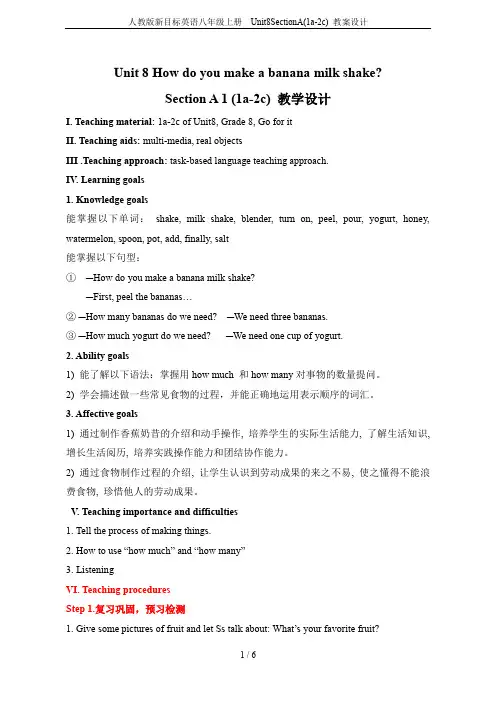
Unit 8 How do you make a banana milk shake?Section A 1 (1a-2c) 教学设计I. Teaching material: 1a-2c of Unit8, Grade 8, Go for itII. Teaching aids: multi-media, real objectsIII .Teaching approach: task-based language teaching approach.IV. Learning goals1. Knowledge goals能掌握以下单词:shake, milk shake, blender, turn on, peel, pour, yogurt, honey, watermelon, spoon, pot, add, finally, salt能掌握以下句型:①─How do you make a banana milk shake?─First, peel the bananas…② ─How many bananas do we need? ─We need three bananas.③ ─How much yogurt do we need? ─We need one cup of yogurt.2. Ability goals1) 能了解以下语法:掌握用how much 和how many对事物的数量提问。
2) 学会描述做一些常见食物的过程,并能正确地运用表示顺序的词汇。
3. Affective goals1) 通过制作香蕉奶昔的介绍和动手操作, 培养学生的实际生活能力, 了解生活知识, 增长生活阅历, 培养实践操作能力和团结协作能力。
2) 通过食物制作过程的介绍, 让学生认识到劳动成果的来之不易, 使之懂得不能浪费食物, 珍惜他人的劳动成果。
V. Teaching importance and difficulties1. Tell the process of making things.2. How to use “how much” and “how many”3. ListeningVI. Teaching proceduresStep 1.复习巩固,预习检测1. Give some pictures of fruit and let Ss talk about: What’s your favorite fruit?2. Give some pictures of drinks and let Ss talk about: What’s your favorite drink?【设计意图】:以轻松愉快的Free Talk交流,问候的内容与本课内容相关,增进彼此感情的同时,自然地导入本节课的话题。
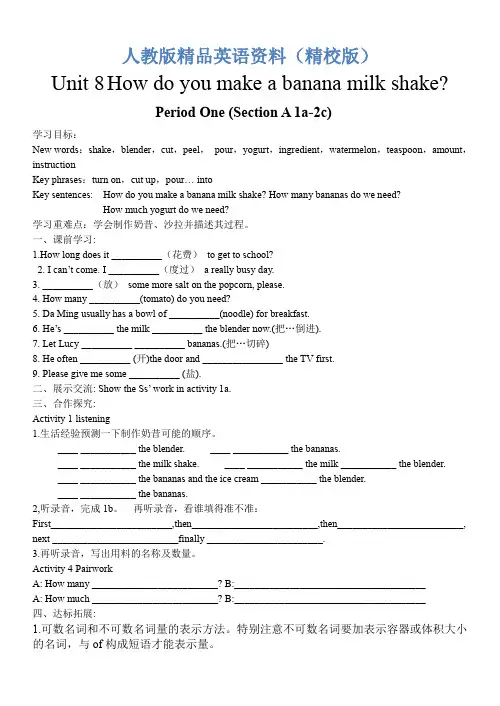
人教版精品英语资料(精校版)Unit 8How do you make a banana milk shake?Period One (Section A 1a-2c)学习目标:New words:shake,blender,cut,peel,pour,yogurt,ingredient,watermelon,teaspoon,amount,instructionKey phrases:turn on,cut up,pour… intoKey sentences: How do you make a banana milk shake? How many bananas do we need?How much yogurt do we need?学习重难点:学会制作奶昔、沙拉并描述其过程。
一、课前学习:1.How long does it __________(花费)to get to school?2. I can’t come. I __________(度过)a really busy day.3. __________(放)some more salt on the popcorn, please.4. How many __________(tomato) do you need?5. Da Ming usually has a bowl of __________(noodle) for breakfast.6. He’s __________ the milk __________ the blender now.(把…倒进).7. Let Lucy __________ __________ bananas.(把…切碎)8. He often __________ (开)the door and ________________ the TV first.9. Please give me some __________ (盐).二、展示交流: Show the Ss’ work in activity 1a.三、合作探究:Activity 1 listening1.生活经验预测一下制作奶昔可能的顺序。
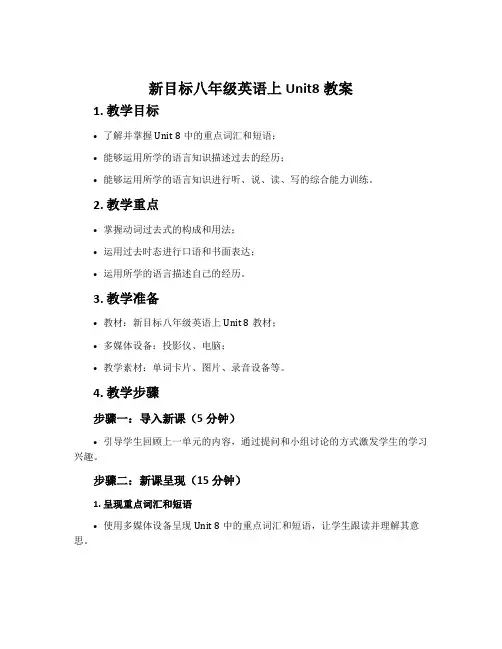
新目标八年级英语上Unit8教案1. 教学目标•了解并掌握Unit 8中的重点词汇和短语;•能够运用所学的语言知识描述过去的经历;•能够运用所学的语言知识进行听、说、读、写的综合能力训练。
2. 教学重点•掌握动词过去式的构成和用法;•运用过去时态进行口语和书面表达;•运用所学的语言描述自己的经历。
3. 教学准备•教材:新目标八年级英语上Unit 8教材;•多媒体设备:投影仪、电脑;•教学素材:单词卡片、图片、录音设备等。
4. 教学步骤步骤一:导入新课(5分钟)•引导学生回顾上一单元的内容,通过提问和小组讨论的方式激发学生的学习兴趣。
步骤二:新课呈现(15分钟)1. 呈现重点词汇和短语•使用多媒体设备呈现Unit 8中的重点词汇和短语,让学生跟读并理解其意思。
2. 引入过去时态•通过给出一段关于自己经历的简短故事,引入过去时态的概念,并解释过去时态的构成和用法。
步骤三:教学练习(25分钟)1. 听说训练•让学生跟随录音回答关于过去经历的问题,提高学生的听说能力。
2. 阅读训练•让学生阅读课文并完成相关的阅读练习,培养学生的阅读理解能力。
3. 写作训练•让学生根据提供的写作指导,写一篇关于自己的过去经历的短文。
通过写作训练,提高学生的写作能力和叙述能力。
步骤四:课堂练习(20分钟)•在教材中选择相关练习题,组织学生进行个人、小组或全班的课堂练习。
步骤五:作业布置(5分钟)•布置相关阅读和写作作业,要求学生在家完成并在下节课交给老师检查。
5. 教学延伸•鼓励学生使用过去时态描述自己的经历,引导学生讨论并分享自己的经历,提高学生口语表达能力。
6. 教学反思本节课通过多种教学方法和形式,使学生在听、说、读、写的各个方面都得到了锻炼和提高。
课堂上设置了许多练习,能够帮助学生巩固所学的知识点,并且在动态的交流中,学生的学习主动性得到了调动。
本节课通过灵活运用教学手段,培养了学生的英语综合能力,并且通过个别辅导和点拨,使学生在应用所学知识的过程中建立信心,更好地完成课堂任务。
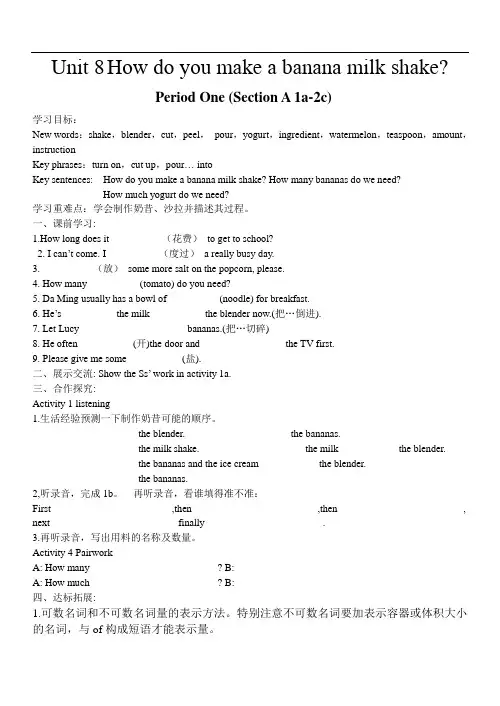
Unit 8How do you make a banana milk shake?Period One (Section A 1a-2c)学习目标:New words:shake,blender,cut,peel,pour,yogurt,ingredient,watermelon,teaspoon,amount,instructionKey phrases:turn on,cut up,pour… intoKey sentences: How do you make a banana milk shake? How many bananas do we need?How much yogurt do we need?学习重难点:学会制作奶昔、沙拉并描述其过程。
一、课前学习:1.How long does it __________(花费)to get to school?2. I can’t come. I __________(度过)a really busy day.3. __________(放)some more salt on the popcorn, please.4. How many __________(tomato) do you need?5. Da Ming usually has a bowl of __________(noodle) for breakfast.6. He’s __________ the milk __________ the blender now.(把…倒进).7. Let Lucy __________ __________ bananas.(把…切碎)8. He often __________ (开)the door and ________________ the TV first.9. Please give me some __________ (盐).二、展示交流: Show the Ss’ work in activity 1a.三、合作探究:Activity 1 listening1.生活经验预测一下制作奶昔可能的顺序。
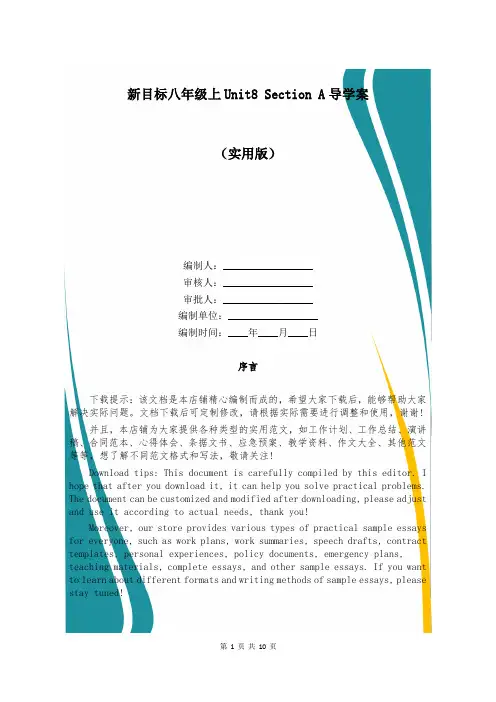
新目标八年级上Unit8 Section A导学案(实用版)编制人:__________________审核人:__________________审批人:__________________编制单位:__________________编制时间:____年____月____日序言下载提示:该文档是本店铺精心编制而成的,希望大家下载后,能够帮助大家解决实际问题。
文档下载后可定制修改,请根据实际需要进行调整和使用,谢谢!并且,本店铺为大家提供各种类型的实用范文,如工作计划、工作总结、演讲稿、合同范本、心得体会、条据文书、应急预案、教学资料、作文大全、其他范文等等,想了解不同范文格式和写法,敬请关注!Download tips: This document is carefully compiled by this editor. I hope that after you download it, it can help you solve practical problems. The document can be customized and modified after downloading, please adjust and use it according to actual needs, thank you!Moreover, our store provides various types of practical sample essays for everyone, such as work plans, work summaries, speech drafts, contract templates, personal experiences, policy documents, emergency plans, teaching materials, complete essays, and other sample essays. If you want to learn about different formats and writing methods of sample essays, please stay tuned!新目标八年级上Unit8 Section A导学案新目标八年级上Unit8 Section A导学案(精选3篇)新目标八年级上Unit8 Section A导学案篇1八年级(上)英语学科导学案出品人:刘贵田审核人:时间:unit1、how often do you eXercise?(section a)一.学习目标(learning aims)1.掌握表示频率的副词及其用法。
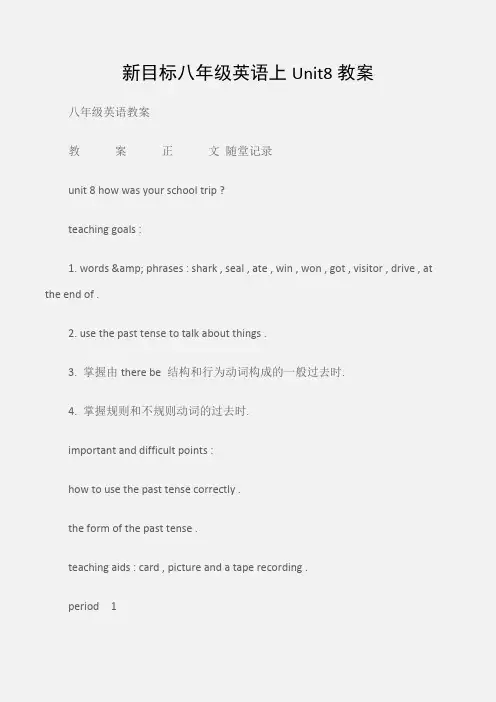
新目标八年级英语上Unit8教案八年级英语教案教案正文随堂记录unit 8 how was your school trip ?teaching goals :1. words & phrases : shark , seal , ate , win , won , got , visitor , drive , at the end of .2. use the past tense to talk about things .3. 掌握由there be 结构和行为动词构成的一般过去时.4. 掌握规则和不规则动词的过去时.important and difficult points :how to use the past tense correctly .the form of the past tense .teaching aids : card , picture and a tape recording .period 1teaching procedures :step 1 leading ingreeting : talk about something the ss did last week .step 2 pre-tasksb page 47 , 1a , 1c .t: what did you do on your last school trip ?look at the picture .guess :what did tina … do ?教案正文随堂记录pairwork : did tina buy a souvenir ? no , … .step 3 while-tasksb page 47 , 1b .listen and check the answers .sb page 48 , 2a , 2b .play the recording and correct the answers.step 4 post-tasksb page 48 , 2c .pairwork : make conversations .ask several students to present their conversations .grammar focus .review the grammar box .ss say the questions and answers . practice reading .教学后记教案正文随堂记录period 2teaching procedures :greeting : talk about what last day off was like .was it a good day off or a terrible day off ?step 2 pre-tasksb page 50 , 1a , 1b .look at the pictures .say something about the pictures .point out the five phrases .ss read after teacher .make sure ss understand what they should do .rank them from 1-5 .pay attention to the conversation in the box on the right .read .pairwork : make conversations .share the students’ conversations .step 3 while-tasksb page 50 , 2a , 2b .say , now you will hear a conversation about what tina and tony did on their last day off .point out the sample answer in 2a .教案正文随堂记录listen carefully twice .fill in the chart.read the sentences in 2b .pay attention to who said these things .play the tape again .listen carefully .check the answers .八年级英语教案ask one student to read the article .ss read and work : correct the statements below .listen to the recording .read after it .ask ss to read together .step 4 post-taskpairwork: make conversations with your partner using these phrases : were there … ? did you see … ? did you go … ?step 5 homeworkmake up a story .教学后记教案正文随堂记录period 3teaching procedures:step 1 leading infree talk .check the homework .step 2 pre-tasksb page 51, part 4 .say ,here are some photos of your last vacation .what did you do ?ask and answer with your partner .question like this : did … ? what … ? were there … ? where … ? how was … ?pairwork .step 3 while-tasksb page51 ,3a .read the letter about the things nick did by ss .explain the new words .play the tape .ss listen and repeat .point to the number 1-5 .point out the sample answer.教案正文随堂记录ss work .then check the answers .play the tape again .practice reading .sb page 51 , 3b .say , imagine you are tony and you’ll give nick a letter .。
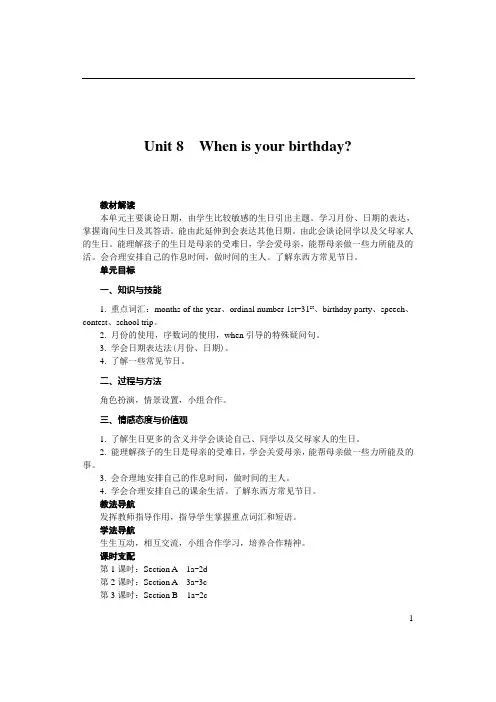
Unit 8 When is your birthday?教材解读本单元主要谈论日期,由学生比较敏感的生日引出主题。
学习月份、日期的表达,掌握询问生日及其答语。
能由此延伸到会表达其他日期。
由此会谈论同学以及父母家人的生日。
能理解孩子的生日是母亲的受难日,学会爱母亲,能帮母亲做一些力所能及的活。
会合理安排自己的作息时间,做时间的主人。
了解东西方常见节日。
单元目标一、知识与技能1. 重点词汇:months of the year、ordinal number 1st-31st、birthday party、speech、contest、school trip。
2. 月份的使用,序数词的使用,when引导的特殊疑问句。
3. 学会日期表达法(月份、日期)。
4. 了解一些常见节日。
二、过程与方法角色扮演,情景设置,小组合作。
三、情感态度与价值观1. 了解生日更多的含义并学会谈论自己、同学以及父母家人的生日。
2. 能理解孩子的生日是母亲的受难日,学会关爱母亲,能帮母亲做一些力所能及的事。
3. 会合理地安排自己的作息时间,做时间的主人。
4. 学会合理安排自己的课余生活。
了解东西方常见节日。
教法导航发挥教师指导作用,指导学生掌握重点词汇和短语。
学法导航生生互动,相互交流,小组合作学习,培养合作精神。
课时支配第1课时:Section A 1a-2d第2课时:Section A 3a-3c第3课时:Section B 1a-2c第4课时:Section B 3a-Self Check1课时教案第1课时Section A1a-2d教学目标一、知识与技能1. 掌握本节课的重点词汇和短语。
2. 掌握句型:When is your birthday? My birthday is on ...二、过程与方法为学生设置情景,进行表演。
小组合作练习对话。
三、情感态度与价值观通过学习,了解同学、朋友及家人的生日,养成关爱他人的意识。
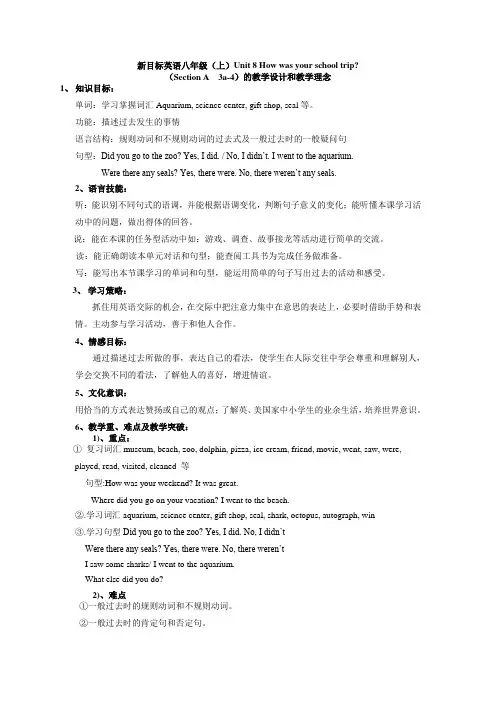
新目标英语八年级(上)Unit 8 How was your school trip?(Section A 3a-4)的教学设计和教学理念1、知识目标:单词:学习掌握词汇Aquarium, science center, gift shop, seal等。
功能:描述过去发生的事情语言结构:规则动词和不规则动词的过去式及一般过去时的一般疑问句句型:Did you go to the zoo? Yes, I did. / No, I didn’t. I went to the aquarium.Were there any seals? Yes, there were. No, there weren’t any seals.2、语言技能:听:能识别不同句式的语调,并能根据语调变化,判断句子意义的变化;能听懂本课学习活动中的问题,做出得体的回答。
说:能在本课的任务型活动中如:游戏、调查、故事接龙等活动进行简单的交流。
读:能正确朗读本单元对话和句型;能查阅工具书为完成任务做准备。
写:能写出本节课学习的单词和句型,能运用简单的句子写出过去的活动和感受。
3、学习策略:抓住用英语交际的机会,在交际中把注意力集中在意思的表达上,必要时借助手势和表情。
主动参与学习活动,善于和他人合作。
4、情感目标:通过描述过去所做的事,表达自己的看法,使学生在人际交往中学会尊重和理解别人,学会交换不同的看法,了解他人的喜好,增进情谊。
5、文化意识:用恰当的方式表达赞扬或自己的观点;了解英、美国家中小学生的业余生活,培养世界意识。
6、教学重、难点及教学突破:1)、重点:①复习词汇museum, beach, zoo, dolphin, pizza, ice cream, friend, movie, went, saw, were,played, read, visited, cleaned 等句型:How was your weekend? It was great.Where did you go on your vacation? I went to the beach.②.学习词汇aquarium, science center, gift shop, seal, shark, octopus, autograph, win③.学习句型Did you go to the zoo? Yes, I did. No, I didn’tWere there any seals? Yes, there were. No, there weren’tI saw some sharks/ I went to the aquarium.What else did you do?2)、难点①一般过去时的规则动词和不规则动词。
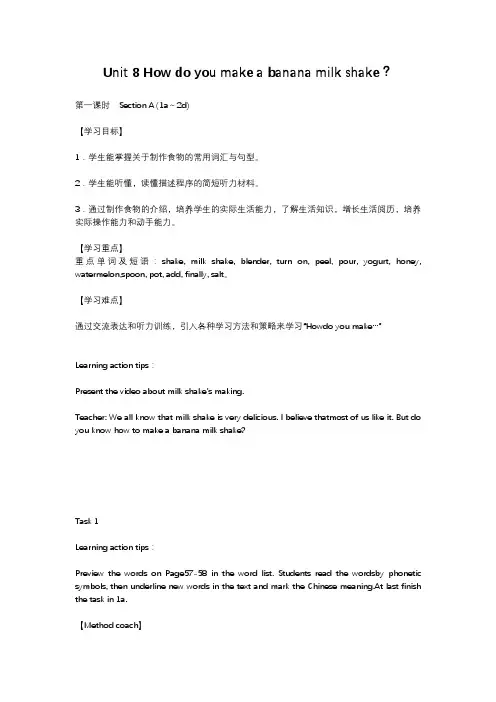
Unit 8 How do you make a banana milk shake?第一课时Section A (1a~2d)【学习目标】1.学生能掌握关于制作食物的常用词汇与句型。
2.学生能听懂,读懂描述程序的简短听力材料。
3.通过制作食物的介绍,培养学生的实际生活能力,了解生活知识,增长生活阅历,培养实际操作能力和动手能力。
【学习重点】重点单词及短语:shake, milk shake, blender, turn on, peel, pour, yogurt, honey, watermelon,spoon, pot, add, finally, salt。
【学习难点】通过交流表达和听力训练,引入各种学习方法和策略来学习“Howdo you make…”Learning action tips:Present the video about milk shake's making.Teacher: We all know that milk shake is very delicious. I believe thatmost of us like it. But do you know how to make a banana milk shake?Task 1Learning action tips:Preview the words on Page5758 in the word list. Students read the wordsby phonetic symbols, then underline new words in the text and mark the Chinese meaning.At last finish the task in 1a.【Method coach】▲turn的相关短语turn on打开turn off 关上turn up(把音量)调大turn down(把音量)调小【辨析】turn on与open(1)turn on 表示“打开(电灯、自来水开关、煤气、无线电等)”,反义短语为turnoff。
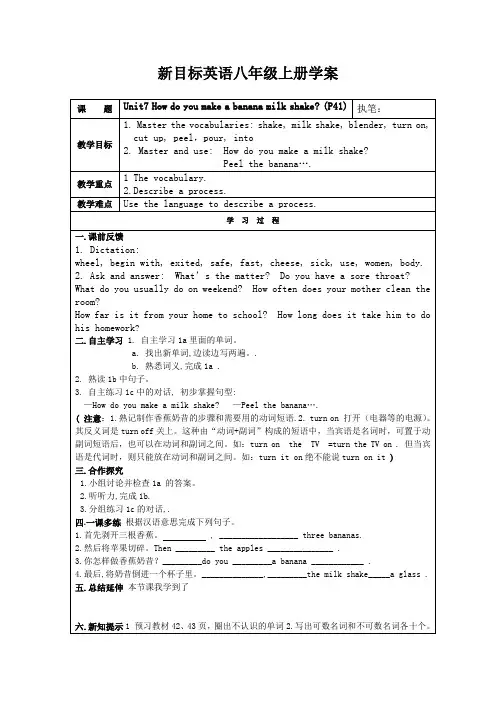
Unit 8 How was your school trip?【单元话题】1. 会谈论过去的事情2.培养自己做事要有计划性3.培养逻辑思维能力4.培养合作意识【重要句型概览】1. What did you do on your school trip?2. Did you go to the zoo?No, I didn‘t. I went to the aquarium.3. Were there any sharks?No, there weren‘t any sharks, but there were.【重要词组概览】go to the aquariums去水族馆take photos照相,拍照hang out with sb.和某人闲逛win a prize获奖(金)have a great time玩得高兴take the bus back to school乘公共汽车回学校lots of=a lot of许多,大量at the end of在……的尽头go for a drive开车兜风help sb. do sth.帮助某人做某事help sb. with sth.在某方面帮助某人thanks for doing sth.感谢某人做了某事day off休假【语法知识聚焦】一般过去时:表示过去曾经发生的动作或出现的状态,以动词的过去式表达,如:I was at the library yesterday afternoon.Tom studied hard and did well in the final exam last year.动词的过去式分为规则动词和不规则动词两种。
1. 规则动词只要在动词词尾加上ed即可。
具体方法是一般情况直接加,如:clean—cleaned;2. 词尾是不发音字母e的,可只加上d,如:like—liked;3. 词尾为重读闭音节,结尾只有一个辅音字母的,应双写该辅音字母,再加上ed,如:stop—stopped;4. 词尾为辅音字母加y的,应将y改为i再加上ed,如:study studie5. 不规则动词有其自己的变化形式,只能分别记忆。
【人教版】新目标八年级英语上册:Unit8单元教学设计一. 教材分析人教版新目标八年级英语上册Unit8主要讲述了关于动物的保护和环境的问题。
本单元的主题是保护动物和环境,让学生了解和认识到动物和环境的重要性,培养学生保护动物和环境的意识。
教材内容包含了动物的保护、环境污染、环保行动等话题,通过学习本单元,学生能够掌握相关词汇和表达方式,提高听说读写的能力。
二. 学情分析八年级的学生已经具备了一定的英语基础,能够进行简单的英语交流。
但是,对于一些复杂的词汇和表达方式,学生可能还比较陌生。
因此,在教学过程中,需要帮助学生理解和掌握这些词汇和表达方式,提高他们的英语水平。
同时,学生对于动物和环境的问题可能了解不多,需要通过教学活动来引导学生关注和思考这些问题。
三. 教学目标1.知识目标:学生能够掌握本单元的重点词汇和表达方式,了解关于动物保护和环境问题的相关知识。
2.能力目标:学生能够运用所学的词汇和表达方式进行听说读写的能力训练,提高英语水平。
3.情感目标:学生能够认识到保护动物和环境的重要性,培养保护动物和环境的意识。
四. 教学重难点1.重点:本单元的重点词汇和表达方式,如动物名称、保护动物的措施、环境污染的表述等。
2.难点:对于一些复杂的词汇和表达方式的理解和运用,如环境保护的重要性、环保行动的实施等。
五. 教学方法1.任务型教学法:通过设定具体的学习任务,让学生在完成任务的过程中学习和掌握知识。
2.情境教学法:通过创设真实的情境,让学生在实际的语言环境中学习和运用英语。
3.合作学习法:通过小组合作的形式,让学生相互交流和合作,共同完成学习任务。
六. 教学准备1.教材:人教版新目标八年级英语上册。
2.多媒体设备:电脑、投影仪、音响等。
3.教学素材:相关动物和环境的图片、视频等。
七. 教学过程1.导入(5分钟)通过展示一些动物和环境的图片,引导学生关注和思考动物和环境的问题。
提问学生对于动物和环境的了解和看法,激发学生的学习兴趣。
单元测试Listening(略)Using LanguageⅠ.Put the words into the correct column.Ⅱ.Choose the correct word in the sentence.1.First ________ three bananas.2.Then ________ the bananas.3.________ the bananas in the blender.4.Next ________ the milk into the blender.5.________ the blender.6.Now ________ the smoothie.Ⅲ.Put the word in its correct order.1.ogrtuy ________ 2.aadls________3.reykut ________ 4.ooeimtsh________ 5.ieepcr ________ 6.zaizp________ 7.eenldrb ________ 8.aimnnnoc________ 9.rtnu no ________ 10.ansooept________Ⅳ.Fill in the blanks.1.Put the mayonnaise on a ________ of bread.2.How many ________ of cinnamon did you put in the fruit salad?3.I like ________ on my turkey sandwich.4.You have to ________ the onions,then add them to the salad.5.________ the milk into the blender.6.Put the apples and bananas into the ________, then add the cinnamon and yogurt. Ⅴ.Put the words in the correct order.EXAMPLE: are What doing you?What are you doing?1.make salad let’s fruit_____________________________________________________________________ 2.apples we need many do how?_____________________________________________________________________ 3.you pizza make how do?_____________________________________________________________________ 4.the into the popper popcorn popcorn put_____________________________________________________________________ 5.up and peppers cut mushrooms_____________________________________________________________________ 6.a for great sandwich here’s recipe a turkey_____________________________________________________________________ 7.put on slices bread first mustard two of_____________________________________________________________________ 8.the hot then pour water blender into_____________________________________________________________________ Ⅵ.Fill in the blanks with“How many”or“How much”.1.________ bananas do we need?2.________ yogurt do we need for the smoothie?3.________ apples did you put in the salad?4.________ cinnamon do we need for this recipe?5.________ mayonnaise is on the sandwich?6.________ onions did you cut up for the pizza?Ⅶ.Choose the correct answers.1.________ apples do we need to make salad?A.How many B.How much C.How long 2.First, ________ two bananas,then put them in the blender.A.cut B.peel C.make3.We have to ________ the apples.A.eat B.pour C.cut up4.—Do we need to ________ water into the bowl?—Yes,we do.A.put B.pour C.peel5.Be careful when you ________ the blender.A.turn on B.turn off C.turn into 6.—Are these ________ necessary to make a pizza?—Of course.A.ingredients B.ingredient C.many ingredients 7.—What should I do next?—Next you should ________ everything into a blender.A.mix B.mix over C.mix up 8.Next,pour a cup of honey ________ the bread.A.into B.on C.to9.________ you have all the ingredients.A.Check B.Checking C.Checked 10.Put two ________ of sugar into the water.A.cup B.cups C.cups of Ⅷ.Cloze Test.Jack: Hi,Jim! What are you going to do next Sunday?Jim: 1 much. Why?Jack: We are going to pick pears 2 the farm. Can you go with us?Jim: That’s a good 3 ! I think it’s much more exciting than 4 . Jack: I agree 5 you.Jim: 6 are we going there?Jack: We are going there 7 bus.Jim: When and where are we going to 8 ?Jack: 9 the road outside my house,at eight o’clock next 10 morning.Jim: OK. See you then.Jack: See you.1.A.Very B.Too C.Nothing D.Something 2.A.on B.in C.to D.of3.A.idea B.way C.question D.work 4.A.have classes B.having classes C.go to school D.at school 5.A.to B.in C.with D.on 6.A.When B.Where C.How D.Why7.A.in B.on C.with D.by8.A.see B.meet C.look D.watch 9.A.On B.In C.At D.To 10.A.Monday B.Saturday C.Sunday D.Friday Ⅸ.Reading Comprehension.Li Ping is going to England. He wants to know something about English people. One day he sees an English girl in the street. Then he comes up to her.“Excuse me, may I ask you some questions?”“Of course you may.”answers the girl politely(礼貌地).“I’ll go to London. What should I notice(注意)when I’m talking with English people in London? ”asks Li Ping.“Well, don’t ask a woman how old she is and…”“But how old are you? ”Li Ping stops the girl and asks suddenly(突然).“I…”The girl gets angry(生气的).“Why do you get so angry?”asks Li Ping. “Now we are in China, not in England, you see”Choose the correct answer:1.What does Li Ping want to know?A.He wants to know the girl’s name.B.He wants to know the girl.C.He wants to know something about English people.D.He wants to know something about America.2.Whom does Li Ping see in the street?A.He sees a girl. B.He sees a boy.C.He sees a woman. D.He sees an old man.3.Does the girl like to answer the first question?A.No,she doesn’t. B.Yes,she does.C.No,she don’t. D.Yes,she do.4.Why does the girl become angry?A.Because Li Ping wants to go to London.B.Because Li Ping wants to know how old she is.C.Because Li Ping wants to know her name.D.Because Li Ping calls her name.5.Does Li Ping say sorry to the girl or not?A.Yes,he is. B.No,he isn’t.C.Yes,he does. D.No,he doesn’t.Checking Yourself1.Write down the useful words you have learned in this unit.(写出本单元学到的生词。
八年级(上)单元测试( Unit 8 )亲爱的同学,好客的Bobby 想邀请你到他家做客。
有兴趣吗?来吧!你会有很多收获的哦。
一、Bobby 想为你制作一份milk shake ,可是他忘了制作程序,你能给他指导指导吗?并说明关键动词(10分)A B C D E F1( )_______ 2( ) _______ 3( A ) put 4( )______ 5( )______ 6( )______二、Bobby 爱学习,也想考考你,试试选出你最满意的。
(15分)()1、How ________ relish do we need for the shake?A someB anyC manyD much()2、_______ the books in the bookcase, Jerry.A PutB To putC PuttingD Puts()3、How ______ your mother _______ fruit salad?A do, doB does, makeC does, doD do, make()4、If you add three _______ nine, you get twelve.A upB onC toD in()5、I want to watch the ball game. Can you _______ the TV?A turn onB turn offC openD close()6、Look! There are __________ on the desk.A four glasses of milkB four glasses of milksC four glass of milkD four glass of milks()7、Which of the following is a healthy drink?A colaB coffeeC shakeD tea()8、— Why not have a drink in the bar? — _________ .A Right.B It’s OK.C You’re welcome.D Good idea.()9、What do western people eat on Thanksgiving Day?A B C D()10、Do I need _________ for London tonight?A leaveB to leaveC leavingD leaves ( ) 11、__________ are all the gifts?A How manyB How muchC How longD How often ( ) 12、Put the ingredients in the container and _________ , please.A mix up itB mix it upC mix up themD mix them up( ) 13、Which is a good eating habit?A Not washing hands before eatingB Eating different foodsC Talking much during meals(餐,饭)D Eating chocolates before meals( ) 14、There is some snow on __________ of the mountain.A groundB topC floorD foot( ) 15、—Would you like some yogurt? — ________________.A Yes, I would.B No, thanks.C Thank you.D It doesn’t matter.三、Bobby 的妹妹给他留了一张便条,有些词不会写,用图片代替了,你能破译出来吗?要注意单词的变形哦!(5分)Bobby,Mum ___________ to say she had no time to cook dinner for us. Would you like to do it? I like ___________but we have no ingredients. Oh, there are some ___________and some other fruits, we can make two___________ of pudding. By the way, don’t forget ___________up the Japanese tofu.Kelly四、Bobby 要去买些食物准备晚饭,陪他去实践实践吧。
一、教案背景
1.面向学生:初级中学八年级学生
2.学科:英语
3.课时:45分钟
4.学生课前准备:
a.预习生词,了解单词词义
b.预习一般过去时态
二、教学课题
新目标八年级上Unit 8 Section A(1a、1b、1c)
三、教材分析
本单元以How was your school trip?为中心话题,围绕着描述“过去旅行发生的事情”展开,学习和运用一般过去时态的一般疑问句Did you go/see/buy…? Were there any…?询问过去的事件,让学生学会谈论和分享过去发生的事情。
本课的教学内容与学生的实际生活密切相关,易于引发学生运用简单的英语进行交际,培养学生的交际能力。
在学习活动中,学生通过交换对过去发生的事情的描述及看法,促进学生之间和师生之间的情感交流,增进情谊。
SectionA的主要学习内容是:复习一般过去时态和动词过去式的规则与不规则变化,学习一般过去时态的两种一般疑问句:Did you…? Were there any…?
四、教学设计。
课题:Unit 8 How was your school trip ?主备人:韦玉梅参备教师:韦玉梅使用时间:11。
19 学生姓名:课时:第一课时学习目标:学会本单元的单词及词汇。
学习重点:重点学会表示周末活动的短语和词组。
辨析几组同义词、短语和词组的用法【课前尝试】(课前完成)一)自学单词,完成下列词形变化。
1. visit (名词)__________2.indoor(反义词)________3.win(名词)________4.end(反义词)__________5.terrible(副词)___________6.rain(形容词)_____ __7.stop(现在分词)_______ 8.drive(名词)_____ 9.luck(形容词)________10. luck(副词)__________ 11.wet (比较级)_____ 12.present(同义词)_______(二)预习课本内容,译一译.(1)went to the beach __ (2)had ice cream(3)went the aquarium (4)took photos________ _(5)went to the zoo (6)had a hamburger_____ ____(7)ate some ice cream (8)hung out with her friends__ __(9) saw some seals_______________(10)bought a wouvenir____ ____(11) saw some sharks____________________________________『通过预习提出问题与困惑』(课前完成)1. Be是原形,am 是第一人称单数形式,is是第三人称单数形式,are是复数形式, being是现在分词,to be是不定式,was和were是过去式。
【人教版】新目标2018年八年级英语上册:Unit 8 单元教案一. 教材分析人教版新目标2018年八年级英语上册Unit 8主要围绕着日常生活中的不同活动展开,让学生能够在真实的情境中运用英语进行交流。
本单元的主题是“Let’s play sports”,通过学习,学生将能够掌握有关运动和日常活动的词汇,学会用一般现在时表达自己的喜好和习惯。
二. 学情分析八年级的学生已经具备了一定的英语基础,能够听懂并运用一些简单的日常用语进行交流。
他们对新事物充满好奇,善于模仿和模仿,喜欢参与各种活动。
但同时,部分学生可能对一些复杂的语法结构和词汇掌握不够扎实,需要教师的耐心引导和反复练习。
三. 教学目标1.知识目标:学生能够掌握本单元的核心词汇和句型,并能运用一般现在时表达自己的喜好和习惯。
2.能力目标:学生能够在真实的情境中运用英语进行日常交流,提高口语表达能力。
3.情感目标:培养学生对体育运动的热爱,增强学生的团队协作能力和自信心。
四. 教学重难点1.重点:学生能够掌握本单元的核心词汇和句型,并能运用一般现在时表达自己的喜好和习惯。
2.难点:学生能够正确运用一般现在时进行句子的构造和表达。
五. 教学方法采用任务型教学法,通过真实的任务和活动,引导学生参与学习过程,提高学生的口语表达能力和团队协作能力。
同时,运用情境教学法,创设真实的情境,让学生在实践中学习和运用英语。
六. 教学准备1.教师准备:准备好本节课所需的教学材料,如PPT、单词卡片、录音机等。
2.学生准备:学生提前预习本节课的内容,了解相关的词汇和句型。
七. 教学过程1.导入(5分钟)通过播放一段关于运动的视频,激发学生的兴趣,引导学生进入本节课的主题。
2.呈现(10分钟)教师向学生展示本节课的核心词汇和句型,通过图片和例句的形式,帮助学生理解和记忆。
3.操练(10分钟)学生分组进行练习,运用所学的词汇和句型进行对话。
教师巡回指导,纠正学生的错误,并给予鼓励。
(此文档为word格式,下载后您可任意编辑修改!) 新目标英语八年级上册学案新目标英语八年级上册学案新目标英语八年级上册学案新目标英语八年级上册学案Unit 8 How was your school trip?【单元话题】1. 会谈论过去的事情2.培养自己做事要有计划性3.培养逻辑思维能力4.培养合作意识【重要句型概览】1. What did you do on your school trip?2. Did you go to the zoo?No, I didn‟t. I went to the aquarium.3. Were there any sharks?No, there weren‟t any sharks, but there were.【重要词组概览】go to the aquariums去水族馆take photos照相,拍照a prize获奖(金).Tom studied the final exam last year.动词的过去式分为规则动词和不规则动词两种。
1. 规则动词只要在动词词尾加上ed即可。
具体方法是一般情况直接加,如:clean—cleaned;2. 词尾是不发音字母e的,可只加上d,如:like—liked;3. 词尾为重读闭音节,结尾只有一个辅音字母的,应双写该辅音字母,再加上ed,如:stop—stopped;4. 词尾为辅音字母加y的,应将y改为i再加上ed,如:study studie5. 不规则动词有其自己的变化形式,只能分别记忆。
其否定句由助动词did加上not构成;疑问句应在主语前加上助动词did,并将原谓语动词变为原形,如:We did not go to the cinema yesterday.Did you did you get to school this morning?一般过去时的时间状语都是明显表示过去的,如:yesterday、last night、last week、in 1998、three months ago等。
【语法练习】用括号中所给动词的正确形式填空1. Tommy, you mustn‟t _____that word. That‟s not a nice wor d.A. saidB. sayC. sayingD. says2. Let‟s _____the classroom together.A. cleanB. cleaningC. cleanedD. to clean3. Shall we _____ some books at the book fair?A. to buyB. boughtC. buyD. buying4. You may _____ Mr Zhang in the kitchen. She ______ dinner for our school next Monday.A. will that school two years ago.A. teachesB. teachC. taughtD. as of CDs. Roy 3(spend) a lot of money on CDs. He 4(buy) one or two new CDs every week. He never5(go) to the cinema or to the theatre. He 6(stay) at ) to music. He often8 (lend) CDs to this way.【阅读理解】One afternoon, Kate and . “Let‟s go to the bridge and we can see fish in the river.” said Kate.“I don‟t know…” Bob said. “Mum told us, …Don‟t go on the bridge.‟ She said it‟s dangerous.”Kate said, “ I am not afraid. Are you?”They walked onto the bridge and began looking for fish in the river. The bridge was a train bridge. Trains went over the bridge three times a day.The children were standing in th e middle of the bridge when they is coming!” Bob shouted. “Run!” He ran to the end of the bridge. He was safe.Kate ran, too, but she fell. The train was coming fast. Kate ran towards Bob. She fell again right on the train tracks (铁轨). There was no time to leave. She between the tracks. A few seconds later, the train went over the girl, but she was not ‟t tell Mum! Don‟t tell Mum!”At last their mother found out about the story. She was angry because they went on the bridge. But she was they went to the bridge to see _____.A. their motherB. fishC. the trainD. the river() 3. When the train came, the children were _____.A. in the middle of the bridgeB. at the end of the bridgeC. on their way to the bridgeD. away from the bridge() 4. Where was Kate when the train was going over right on the train tracks (铁轨). B. Kate ran towards Bob.C. She between the tracks.D. She stood up and cried.() 5. When their mother knew about the story, she was _____.A. ‟t 应该与动词原形连用, 因此答案为B.2. Let‟s=Let us, 动词let 应该接动词原形, 做宾语补足语, let sb. do sth, 因此答案为A.3. 情态动词shall应该与动词原形连用,因此答案为C.4. 情态动词may应该与动词原形连用,因此答案为B.5. 根据时间状语this morning, 可知本题为一般过去时, 因此答案为D.6. 由“Mrs Black is in the kitchen.” 可知本题为现在进行时因此答案为D.7. 根据题中的“The boy is standing at the corner.” 可知第一个空的答案为现在进行时, 又根据“for as引导的时间状语从句, 主句用一般将来时, 从句通常用一般现在时代替一般将来时, 因此答案为A.【Cloze】本片短文所叙述的故事发生在过去(一年以前),因此,都用一般过去时,答案为: 1. died 2. left 3. spent 4. bought 5. went6. stayed7. listened8. lent9. kept10. lost【阅读理解】1. D2. B3. A4. C5. D1. 根据原文“Kate and see fish in the river”,因此,答案为B3. 根据原文“The children were standing in the middle of the bridge” 部分以及接着一句“A train is coming”, 答案为A.4. 根据原文“She between the tracks” 部分,答案为C.5. 根据原文“She was angry because they went on the bridge. But she was we began to climb the I got the bus.我注意到那些男孩子上了公共汽车。
5. 使役动词let, make, ‟t let you get into the classroom.如果你穿着牛仔裤,老师不会让你进教室。
Unit 8 How was your school trip?【单元话题】1. 会谈论过去的事情2.培养自己做事要有计划性3.培养逻辑思维能力4.培养合作意识【重要句型概览】1. What did you do on your school trip?2. Did you go to the zoo?No, I didn‟t. I went to the aquarium.3. Were there any sharks?No, there weren‟t any sharks, but there were.【重要词组概览】go to the aquariums去水族馆take photos照相,拍照a prize获奖(金).Tom studied the final exam last year.动词的过去式分为规则动词和不规则动词两种。
1. 规则动词只要在动词词尾加上ed即可。
具体方法是一般情况直接加,如:clean—cleaned;2. 词尾是不发音字母e的,可只加上d,如:like—liked;3. 词尾为重读闭音节,结尾只有一个辅音字母的,应双写该辅音字母,再加上ed,如:stop—stopped;4. 词尾为辅音字母加y的,应将y改为i再加上ed,如:study studie5. 不规则动词有其自己的变化形式,只能分别记忆。
其否定句由助动词did加上not构成;疑问句应在主语前加上助动词did,并将原谓语动词变为原形,如:We did not go to the cinema yesterday.Did you did you get to school this morning?一般过去时的时间状语都是明显表示过去的,如:yesterday、last night、last week、in 1998、three months ago等。